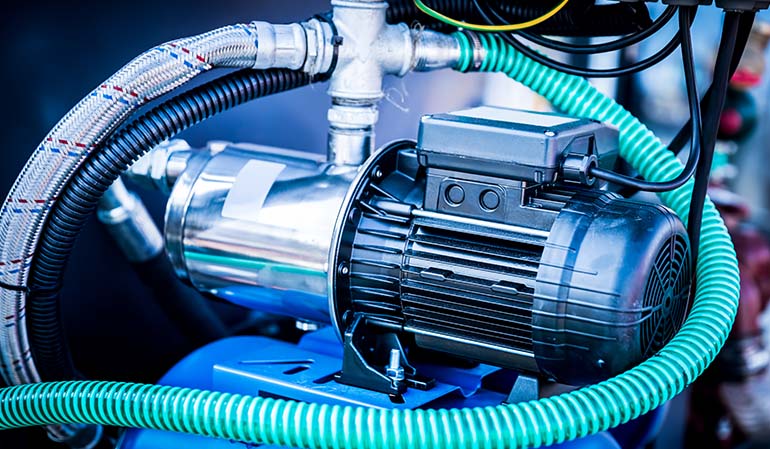
Industrial Motors – 3 Main Types & Features
A generator converts mechanical energy to electrical energy, whereas a motor converts electrical energy into mechanical energy. Both motors and generators work based on the Fleming’s rule and the principle behind the working of these devices is electromagnetic induction. In this guide, we walk you through the three key industrial motors and their functions.
What are Electrical Motors?

Technically speaking, a motor is an electro-mechanical device that converts electrical energy to mechanical energy. There are numerous types of motors based on their application.
Two Major Classification of Motors
Motors are classified into two major types:
• AC Motors
• DC Motors
• DC Motors
DC Motors (Direct Current)

As the name implies, these motors work only in direct current. They are of the following categories:
• Series Motors – Primarily used in vacuum cleaners, sewing machines, air compressors, and cranes.
• Shunt Motors – They are used in centrifugal pumps, fans, lathe machines, conveyor belts, lifts, spinning machines, weaving machines and blowers.
• Compound Motors – They are used in elevators, rolling mills, heavy planners, presses, shears and conveyors.
AC Motors (Alternating Current)

These motors work on alternating current and are highly efficient. They contain a copper-wounded stator and rotor that work on electromagnetism. Some of the common types of AC motors include:
• Synchronous Motors – Primarily used in drilling machines and other devices where accuracy is key. Other applications of synchronous motors include speed controllers, timers, clocks, metering pumps, electromechanical robots, etc.
• Induction Motors – These are motors that are primarily used in automobiles, water pumps, kitchen appliances, air conditioners and fans.
• Linear Motors – When compared to other AC motors, linear motors have different operational and functional characteristics. They are used in magnetic levitation tracks, ground-based rails, monorails and roller coasters.
• Adjustable Motors – They are used in water cooling equipment, electrical power plants, cargo pumps, marine and land machinery.
• Universal Motors – They are used in kitchen blenders, dryers, vacuum cleaners, high-power engineering railway traction mechanisms and drill machines.
Now, that we’ve seen the basics of AC and DC motors,
let’s turn our attention to common industrial motor types:
let’s turn our attention to common industrial motor types:
1. AC Induction Asynchronous Motor

The majority of motors used in industries are three-phase AC motors. Since these motors are highly-reliable and of low cost, they are the preferred choice for industrial applications.
The electric current in the stator generates a rotating magnetic field that induces an electric current in the rotor. The current generated in the rotor creates a magnetic field that reacts with the magnetic field in the stator, causing the rotor to rotate.
The induction motor operates at a speed slightly lower than synchronous speed. Hence, the name asynchronous, as the rotor rotates slower than the stator, to induce the rotating magnetic field. If the rotor rotates faster than the stator, then a current is induced in the stator instead of the rotor. In such cases, the induction motor acts as a generator.
Induction motors are quite inexpensive – as they need only electromagnets. They are highly reliable, and can withstand daily wear up to certain levels. Affordability, simplicity, and reliability are the three reasons why most industrial facilities use AC induction motors.
2. AC Synchronous Motor

As the name implies, in this motor, the rotation of the shaft is synchronised with the frequency of the current that comes into the motor. The magnets in the stator generate an electromagnetic field, which rotates based on the current frequency.
The rotor too contains electromagnets or permanent magnets that cause the shaft to rotate. The rotor is physically connected to the electric current with the help of a commutator. The motor is termed as synchronous as the speed of rotation of the rotor is the same as the stator’s magnetic field.
AC synchronous motors have higher power efficiency than asynchronous motors. However, they are less commonly used due to their higher cost.
3. DC (Direct Current) Motors

Ever since the introduction of AC motors, DC motors have taken a backseat. Still, they are used in certain applications. In a DC motor, the stator generates a static magnetic field, while the rotor produces a rotating magnetic field. The rotor’s magnetic field is aligned with the stator’s magnetic field.
Instead of electromagnets, a DC motor uses a permanent magnet to generate the magnetic field. As a result, the magnetic field is always on, irrespective of whether the motor is operating or not. The potential downside is that DC motors attract other magnetic materials nearby posing a safety risk in an industrial setting. DC motors are also bulkier and heavier, due to the use of permanent magnets. Besides these three types of industrial motors, there are several other specialised motors, depending on the application. To find the best industrial motors in India, reach out to EuroIndustriel, your No.1 industrial supply partner in India.















